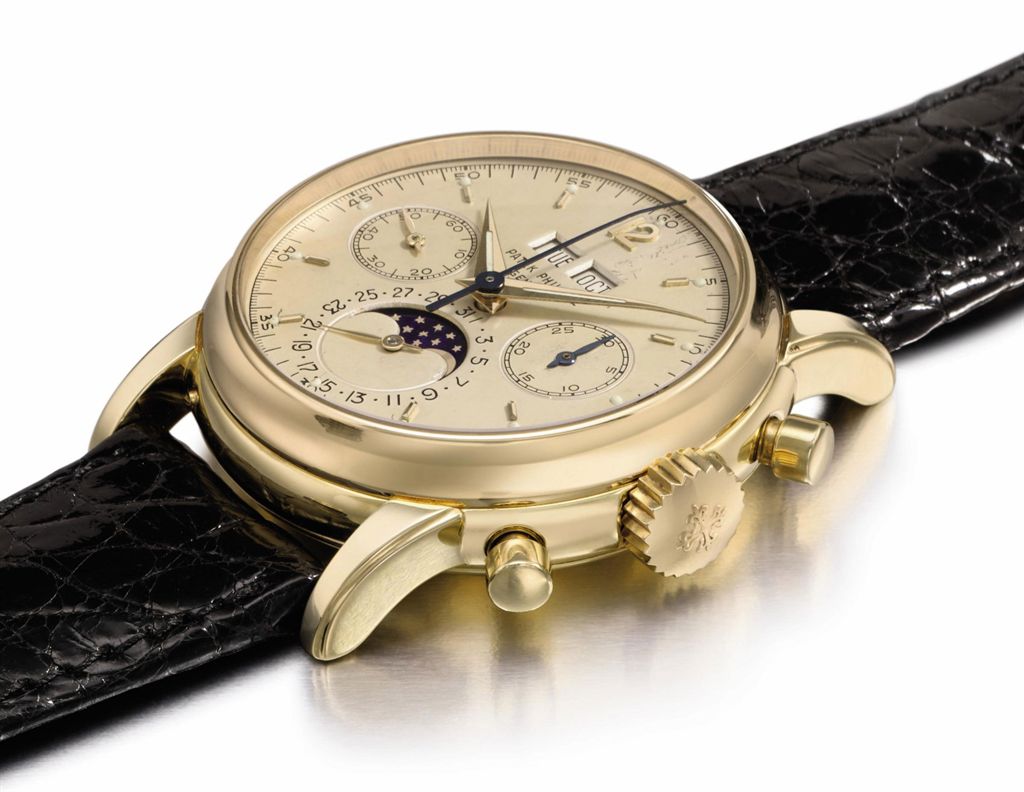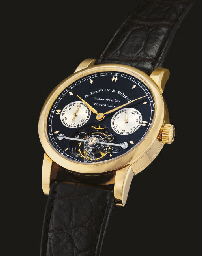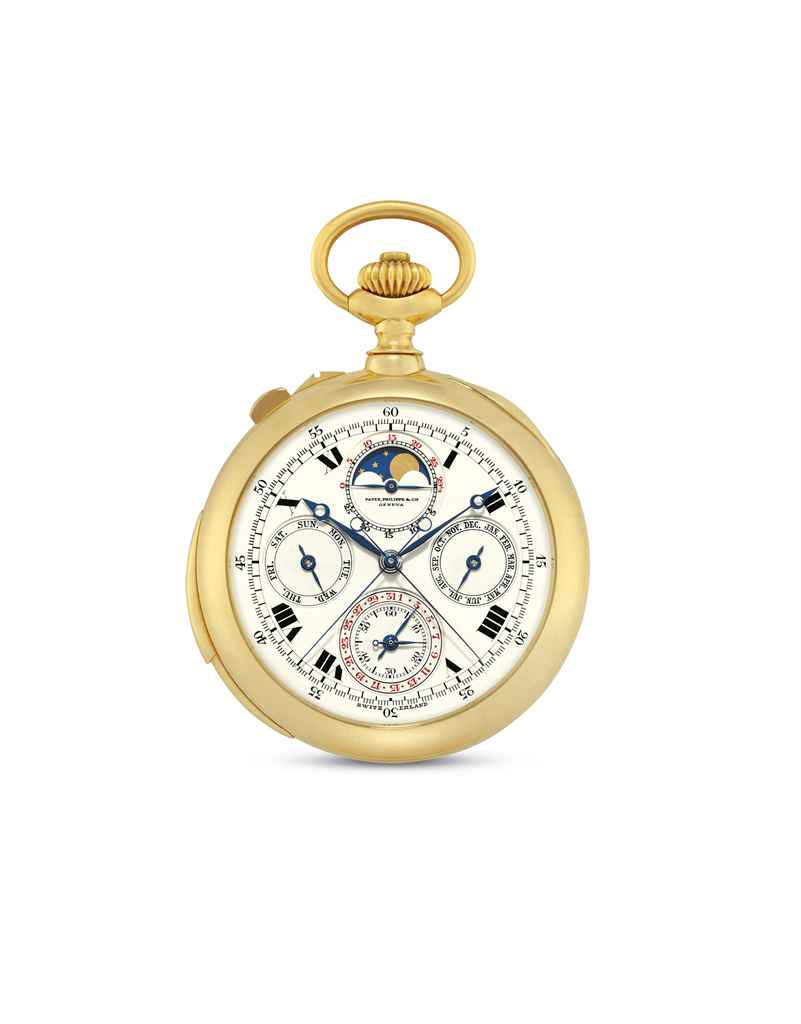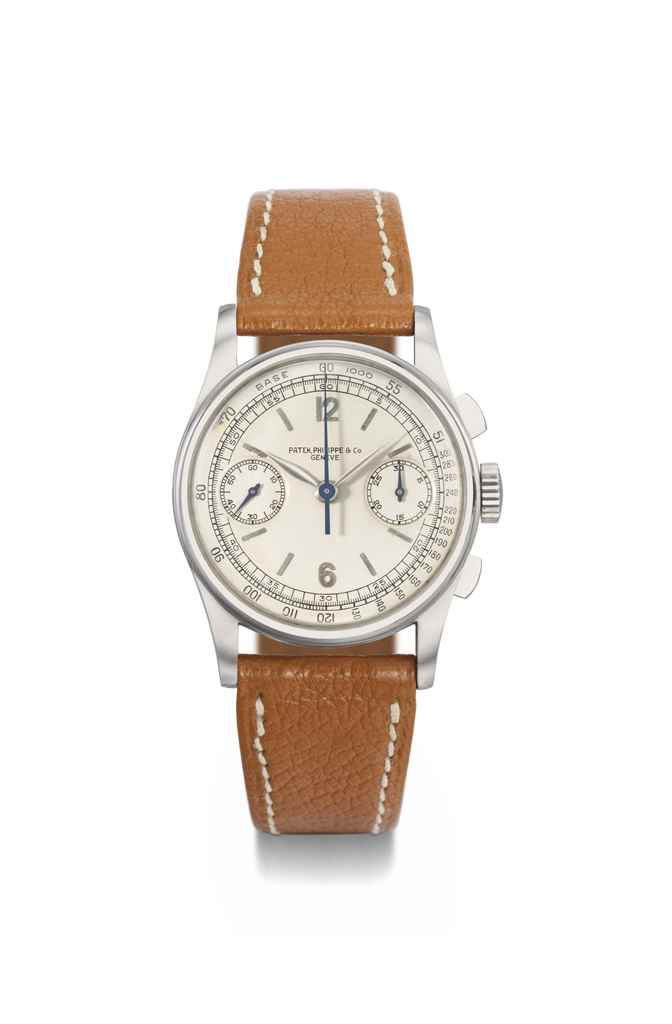A fine and rare George II gilt brass mounted burr walnut table clock Robert Higgs, London, circa 1750 The six pillar twin chain fusee bell striking movement with verge escapement regulated by small lenticular bob pendulum incorporating rise/fall regulation to the suspension and leafy foliate scroll engraved backplate signed Robert Higgs, London to a central cartouche, the 7 inch brass break-arch dial with shaped silvered maker's nameplate engraved Robert Higgs, London beneath false bob aperture to the finely matted centre within applied silvered Roman numeral chapter ring with Arabic five minutes to outer track, the lower angles applied with female mask and foliate scroll cast spandrel mounts, the upper angles incorporating subsidiary silvered Adelantar/Atrafar and Tocar/Silencio selection dials beneath arch with further calendar ring enclosing a matted centre and flanked by conforming Indian head cast mounts, the impressive burr walnut veneered inverted bell top case capped with ball and spire finial to the scroll-outline upstand over gilt brass upper moulding and four further gilt finials to superstructure, the front with further gilt brass principal top moulding above door applied with gilt half-round raised borders to the dial aperture and upper quadrant frets flanked by canted angles adorned with fine female caryatid and tied rose drapery cast mounts, the sides with generous hinged brass handles over circular and concave-topped glazed apertures with raised gilt brass surrounds, the rear matching the front with caryatids to angles, on gilt cavetto moulded shallow skirt base with generous cast squab feet, 51cm (20ins) excluding top finial; 56cm (22ins) high overall. Robert Higgs is recorded in Baillie, G.H. Watchmakers & Clockmakers of the World as apprenticed in 1743 and gaining his Freedom of the Clockmaker's Company in 1750. He worked from Sweetings Alley and took his brother Peter into partnership in 1770. James Evans is recorded by Baillie as also working from Sweetings Alley from 1773. In 1775 he went into partnership with Robert and Peter Higgs; the firm subsequently moved to Exchange Alley and continued in business until around 1825. The partnership of Higgs and James Evans specialised in producing clocks for the export market - particularly to Spain hence a significant proportion of surviving examples being annotated and signed in Spanish. The current lot is a particularly impressive model with fine quality burr walnut veneers and crisply cast fire-gilt brass mounts echoing the work of the finest makers of the period such as John Ellicott Walnut veneered table clocks from this period are notably rare. The possible reasons for this are given by Richard Barder in The Georgian Bracket Clock (pages 50-51) where it is suggested that the general shortage of walnut after the harsh winter of 1709 meant that veneers were mainly reserved for the best pieces of furniture or high-status longcase clocks. Table clocks being relatively small objects suited the use of ebony or ebonised finishes better (with the brass and silvered finishes of the dial and mounts creating a pleasing 'contrast' with the black finish) thus the fashion for black veneers probably persisted out of necessity until figured mahogany veneers became accessible/fashionable (from the 1760's). The current lot can be stylistically dated very close to 1750 hence would have been one of the first clocks made by Robert Higgs after he gained his freedom of the Clockmakers' Company. Interestingly the two subsidiary dials within the upper spandrels areas are annotated in Spanish indicating that the clock was supplied to an Iberian client. However the signature to both the dial and backplate are written in their English form which perhaps suggests that the clock was possibly originally made for the domestic market but ended up being exported to Spain. The fact that the clock was supplied for export to Spain indicates that Robert Higgs was forming relationships with Span
A fine and rare George II gilt brass mounted burr walnut table clock Robert Higgs, London, circa 1750 The six pillar twin chain fusee bell striking movement with verge escapement regulated by small lenticular bob pendulum incorporating rise/fall regulation to the suspension and leafy foliate scroll engraved backplate signed Robert Higgs, London to a central cartouche, the 7 inch brass break-arch dial with shaped silvered maker's nameplate engraved Robert Higgs, London beneath false bob aperture to the finely matted centre within applied silvered Roman numeral chapter ring with Arabic five minutes to outer track, the lower angles applied with female mask and foliate scroll cast spandrel mounts, the upper angles incorporating subsidiary silvered Adelantar/Atrafar and Tocar/Silencio selection dials beneath arch with further calendar ring enclosing a matted centre and flanked by conforming Indian head cast mounts, the impressive burr walnut veneered inverted bell top case capped with ball and spire finial to the scroll-outline upstand over gilt brass upper moulding and four further gilt finials to superstructure, the front with further gilt brass principal top moulding above door applied with gilt half-round raised borders to the dial aperture and upper quadrant frets flanked by canted angles adorned with fine female caryatid and tied rose drapery cast mounts, the sides with generous hinged brass handles over circular and concave-topped glazed apertures with raised gilt brass surrounds, the rear matching the front with caryatids to angles, on gilt cavetto moulded shallow skirt base with generous cast squab feet, 51cm (20ins) excluding top finial; 56cm (22ins) high overall. Robert Higgs is recorded in Baillie, G.H. Watchmakers & Clockmakers of the World as apprenticed in 1743 and gaining his Freedom of the Clockmaker's Company in 1750. He worked from Sweetings Alley and took his brother Peter into partnership in 1770. James Evans is recorded by Baillie as also working from Sweetings Alley from 1773. In 1775 he went into partnership with Robert and Peter Higgs; the firm subsequently moved to Exchange Alley and continued in business until around 1825. The partnership of Higgs and James Evans specialised in producing clocks for the export market - particularly to Spain hence a significant proportion of surviving examples being annotated and signed in Spanish. The current lot is a particularly impressive model with fine quality burr walnut veneers and crisply cast fire-gilt brass mounts echoing the work of the finest makers of the period such as John Ellicott Walnut veneered table clocks from this period are notably rare. The possible reasons for this are given by Richard Barder in The Georgian Bracket Clock (pages 50-51) where it is suggested that the general shortage of walnut after the harsh winter of 1709 meant that veneers were mainly reserved for the best pieces of furniture or high-status longcase clocks. Table clocks being relatively small objects suited the use of ebony or ebonised finishes better (with the brass and silvered finishes of the dial and mounts creating a pleasing 'contrast' with the black finish) thus the fashion for black veneers probably persisted out of necessity until figured mahogany veneers became accessible/fashionable (from the 1760's). The current lot can be stylistically dated very close to 1750 hence would have been one of the first clocks made by Robert Higgs after he gained his freedom of the Clockmakers' Company. Interestingly the two subsidiary dials within the upper spandrels areas are annotated in Spanish indicating that the clock was supplied to an Iberian client. However the signature to both the dial and backplate are written in their English form which perhaps suggests that the clock was possibly originally made for the domestic market but ended up being exported to Spain. The fact that the clock was supplied for export to Spain indicates that Robert Higgs was forming relationships with Span















Try LotSearch and its premium features for 7 days - without any costs!
Be notified automatically about new items in upcoming auctions.
Create an alert